Atlantic Monthly Contributors's Blog, page 386
July 21, 2015
Why an F-16 Hit a Cessna, and Some More-Upbeat Updates

Updates from past reports, one of them grim-toned and the others more encouraging. The grim one first:
Why the Fighter Jet Hit the Little Propeller Plane.
 A British-registered Cessna 150, like the one involved in the crash two weeks ago. (Adrian Pingstone / Wikipedia)
A British-registered Cessna 150, like the one involved in the crash two weeks ago. (Adrian Pingstone / Wikipedia) Two weeks ago a U.S. Air Force F-16 hit a little Cessna 150 propeller airplane while both were in the air near Charleston, South Carolina. The Air Force pilot ejected to safety; the two people aboard the Cessna were killed. I wrote about the larger challenge of separating military and civilian general-aviation aircraft here.
Today the National Transportation Safety Board released its “preliminary information” on the crash. Final NTSB assessments can take many months, often years, to complete. This preliminary report has some compelling details. A lot of attention will be paid to the sequence described here.
The F-16 is making a practice instrument approach to Charleston airport, on a path that turns out to directly intersect with the Cessna’s as it is taking off from the small-Berkley County airport:
At [time] 1100:18, the controller advised the pilot of the F-16, “Traffic 12 o'clock, 2 miles, opposite direction, 1,200 [feet altitude] indicated, type unknown.” [This was the Cessna, which because it was outside Charleston’s “Class C” controlled airspace was not required to be in touch with the controller.]
The F-16 pilot responded and advised the controller that he was "looking" for the traffic.
At 1100:26 [eight seconds later], the controller advised the F-16 pilot, “Turn left heading 180 if you don't have that traffic in sight.” The pilot responded by asking, “Confirm 2 miles?”
Eight seconds later, the controller stated, “If you don't have that traffic in sight turn left heading 180 immediately.” [The word immediately is one you don’t hear very often from air traffic controllers. When you do, you know they mean it. You’re taught to do what they say immediately — turn right, turn left, climb, descend — and only then talk with them about it or ask further details.]
Over the next 18 seconds, the track of the F-16 began turning southerly. [Emphasis added.]
At 1100:49 [15 seconds after the first instruction to turn], the radar target of the F-16 was located 1/2 nautical mile northeast of the Cessna, at an indicated altitude of 1,500 feet, and was on an approximate track of 215 degrees. [That is, not yet at the requested heading of 180 degrees.] At that time, the Cessna reported an indicated altitude of 1,400 feet, and was established on an approximate track of 110 degrees.
The rest of the report describes the process until the planes met in the sky.
To spell this out: Some 30 seconds before the collision, the air-traffic controller was alerting the Air Force pilot that another plane might be in its path. Between sweeps of the radar beam there is some delay in radar-screen readings catching up with the planes’ real positions, so controllers must anticipate their paths. More than 20 seconds before the crash, the controller told the Air Force pilot to turn left, away from the other plane. More than 15 seconds before the crash, the controller said “turn left immediately.” For whatever reason this did not avert the crash. Exactly why will be the subject of the ongoing investigation.
Maine Maritime on Top
Now some better news. I’m a skeptic of college rankings, for reasons John Tierney explained well here. (And I say this as a one-time editor of US News & World Report, but that’s a longer and different story.) Yet, like everyone, I naturally will cite rankings when they happen to highlight an important result.
That’s very much the case with Money magazine’s recent set of rankings, which had the Maine Maritime Academy, in Castine, Maine, as its number-one overall public university, right ahead of Berkeley and UC Irvine. See for yourself:
 Money magazine.
Money magazine. Why do I mention this? As an extension of our American Futures coverage of Eastport, Maine, our colleague John Tierney spent time in Castine reporting on what the Maine Maritime Academy had meant to the students and the economy of the state. You can read his first report here, and a follow-up, on the virtue of this kind of practical education, here. Congratulations on this deserved honor to our friends in Maine, including the chairman of the MMA board, Captain Bob Peacock of Eastport.
Downtown Revival in Fresno
 The people, organizations, and ideas reshaping the country
The people, organizations, and ideas reshaping the countryRead More
In a long series of posts this spring, we described Fresno’s ambition to rebuild itself as a commercial, technological, and even artistic center. Part of this drama centered on the Fulton Street Mall. In the 1960s, the decision to close off a multi-block section of downtown was seen as a progressive, civic-minded step. Then sprawl, white flight, and other common urban ills drained the downtown of its life and business. Fresno is now in the middle of a campaign to revive Fulton Street — in part, as explained here and here, by re-opening it to cars.
Reader Dicky Murphy of Los Angeles, who went up to Fresno to see for himself, sends this report:
I wanted to forward you a few pictures that I thought you might enjoy.
The first is from Saturday night’s “Summer Sweat” festival, which was hosted by Peeve's Public House. It was the inaugural “sweat,” with bands playing day and night and a significant crowd of young people. I got the sense that there was something happening downtown.
Dicky Murphy
The other is taken from the Tioga Sequoia brewery [previously here] across from Chukchansi Stadium. I was planning to see the Grizzlies play but, believe it or not, the game got cancelled on account of RAIN and LIGHTNING!
Dicky Murphy
The photo was taken just after the storm. Perhaps a ray of hope in a drought-stricken land.
p.s. Side note on local perception of downtown. Upon arriving at [a major hotel] where I stayed, which is located just off the Fulton Mall, I asked the concierge for directions to Fulton Mall. His response: “Oh, well there's not much there. Downtown Fresno shuts down at night.”
Never has a concierge tried to talk me OUT OF seeing the local sights.
Of course, Fresno was anything but shut down that night. It felt like a tiny Portland or Austin or any other hip city that everyone’s talking about. Guess it goes to show the “I Believe in Downtown Fresno” team has their work cut out for them.
Okay, One More.
“Scientists Launch Riverside’s First Brewery Incubator.” This was a story I had to read (even though it was from last year), and am glad I did. Thanks to all for the updates.









A Prairie Home Replacement

Like Guy Noir, private eye, Garrison Keillor is preparing to turn out the light on the twelfth floor of the Acme Building and slip into the dark night of a city that knows how to keep its secrets. The longtime host announced Monday he would step down from A Prairie Home Companion, his 41-year-old public radio variety show, in a year’s time. But his retirement isn’t the death knell for the Keillor universe—the twilight of those Norwegian bachelor farmers, the last batch of Powdermilk Biscuits, Dusty and Lefty’s last roundup—because Chris Thile, the one-time child prodigy mandolinist for Nickel Creek and Punch Brothers, will take over in his stead.
Related Story
If Famous Poets Had Written 'The Star-Spangled Banner'
Thile’s anointment will be a test of just why people feel so strongly about A Prairie Home Companion—some positive, some extremely negative, some just drowsy from the soothing tones of Keillor’s gravelly bass intonation. In a statement to the AP Monday, Thile said he and the incumbent “have lengthily discussed the future of the show with me as host and agree that we should give it a go. There are, for course, plenty of details to iron out, but I'm very excited!” Keillor, for his part, said he expected Thile to return the show to its roots as a musical variety show. If you listen to PHC regularly, it’s clear that Keillor cares a great deal about the music programming. He chooses the guests carefully, speaks to them with real interest and obvious research, and joins them for musical numbers. This may be a peculiar sort of music—it’s literally your father’s music—but it isn’t just window dressing in the way musical guests often can be.
But is that why listeners tune in week after week? I suspect not. What they want is to hear Keillor’s self-consciously cheesy skits—Guy Noir and the American Duct Tape Council and the old-school radio special-effects gags. And, of course, they want to hear Keillor’s soothing, mellow relation of that week’s news from the fictional Lake Wobegon. What Keillor is offering listeners is a set of comfy, musty, fusty, and dusty Midwestern roots: “The little town that time forgot, and the decades cannot improve.” It’s a place the listeners probably didn’t come from—these are coastal NPR elites, after all—and that never existed anyway, which is the attraction: familiar enough to soothe, fictional enough to be endearing.
The Lutheran church choir director; the wistfully aging parents; the above-average children; the matronly, melancholy, good-hearted waitresses; the thick, red-velveted town theater and its majestic old Wurlitzer—it’s this idealized image of middle America that either draws listeners in, hoping for a brief respite in their Saturday night, or drives them away, rolling their eyes at the cornball shtick. Peter Ostrushko is a great musician, but it’s unlikely 4 million listeners a week are tuning in to hear him play folk standards.
So the question is whether they’ll tune in to hear Thile do it. In some ways, Thile is a natural choice. Like Keillor, he’s a consummate showman with a flair for the whimsical, though his sensibility may skew closer to the twee than the corny. He loves roots music and has cred with musicians. He’s already a ubiquitous presence on public radio. But the Californian doesn’t have much of a claim on the Midwest, and it seems much of his success will hinge on his ability as a raconteur. Although Keillor says the news from Lake Wobegon will go the way of so many small-town news outlets and vanish, some fancy Keillor as a modern-day Mark Twain, and storytelling is a fundamental element of the show.
Even if Thile is a good fit for A Prairie Home Companion, A Prairie Home Companion is a curious fit for Thile. At 34, he’s less than half Keillor’s age and has a busy musical career. He has frequent gigs with Punch Brothers, your snobby bluegrass-fan friend’s answer to Mumford and Sons. Nickel Creek, the band he co-founded at eight, recently reunited after a hiatus. He’s a sought-after instrumentalist for other musicians and collaborates with symphonies and classical musicians like Edgar Meyer and Yo-Yo Ma. In 2012, he won a MacArthur Genius grant. Thile isn’t a lazy revivalist or formulaic pop-confectioneer—though he’s an earnest young man, his mandolin playing is truly astonishing, and Punch Brothers strives for musical innovation. A typical set might include a few bluegrass standards, a passel of originals, a dash of Debussy, and one of the all-acoustic Radiohead covers that have made the group Internet celebrities:
What will Thile have to sacrifice to take on the show, and how long will he do it? Having been a national star before he was even in his teens, Thile may be aging more quickly than the rest of us, but he still seems too young and ambitious for the velvet handcuffs of a weekly radio show that’s had a single host for the past four decades.
Of course, Keillor has never been quite as fusty and backward as his detractors like to assume—or as his fans like to imagine. Like Thile, he keeps a prickly, challenging interior under a crunchy, sugary shell. Even as Keillor plays with the nostalgia of old-time radio, he’s subverting those tropes and tweaking historical memory and the mores of small-town Minnesota. The show has long been a platform for its host’s progressive politics (this is public radio, after all), and anyone who doubts Keillor’s sharp edge should read his famous 2006 evisceration of a book by Bernard-Henri Levy, whom he describes as “a French writer with a spatter-paint prose style and the grandiosity of a college sophomore” with a “childlike love of paradox,” who “worships Woody Allen and Charlie Rose in terms that would make Donald Trump cringe with embarrassment.” (Timely!)
When I first read the Levy review, it was a revelation—I’d always suspected Keillor’s tongue was lodged in his cheek, but could never quite tell for sure, or how much. Reading him mow down Levy’s lazy stereotypes of Americans and America, it becomes clear how much A Prairie Home Companion is a loving skewering of many of the conventions that it seems to propagate.
Does earnest young Mr. Thile have the skepticism required to carry through this satire? Most listeners probably won’t care. But his success will likely hinge on whether he can offer a satisfying replacement for Keillor’s grandfatherly, Midwestern balm. If he can’t it will indeed be a very quiet week in Lake Wobegon, Minnesota, out there on the edge of the prairie.









Waco Is Suppressing Evidence That Could Clear Innocent Bikers

Why is Waco, Texas, fighting to suppress multiple videos of the shootout that killed nine bikers at the Twin Peaks restaurant on May 17? Why are some attorneys in the case now prohibited from talking to the press? And why haven’t Waco officials revealed how many of the nine victims were killed by bullets from police officers’ guns?
These are the most pressing questions as 177 people await a grand jury’s decision about whether they will be indicted for murder, conspiracy, or on lesser charges after attending a regularly scheduled meeting of motorcycle enthusiasts that turned violent.
Attendees included members of violent-outlaw motorcycle gangs and innocuous clubs. Many members of both groups credibly claim that they had nothing to do with a fight at the meeting. An Associated Press review of surveillance footage not yet released to the public suggests that most present fled from the gunfire rather than participating in it. Over the last two months, motorcyclists swept up in the mass arrest following the carnage have lost jobs, been evicted from apartments, and even lost custody of children. And every day that authorities continue their opposition to sunlight in the case delays vindication for the innocents who’ve had their lives upended. The state loses little by dragging its feet while accused innocents pay dearly.
Worrisome aspects of the case include:
Waco and its police department could be liable for millions of dollars in damages if litigants can prove that they arrested bikers without probable cause, violating their civil rights; or that Waco police shot and killed innocents. Yet the grand jury that will decide whether to indict the bikers is reportedly being led by a longtime detective in the Waco police department––an arrangement 








Amy Schumer and the Promise of the Ladyjerk

“Jerk,” as an epithet, is generally understood to describe guys. As are—apologies for the language, but it’s part of the point—“asshole” and “douchebag” and “dick” and “prick.” While these insults may often owe their etymologies to the features of the male undercarriage, their histories are, at this point, almost irrelevant: Their value, as we use them today, is their elegant ability to consider the deeper, bigger question of human goodness. Is he nice, or not? A decent guy, or no?
Related Story
Their value, as well, is that their subtle variations suggest the nuances that lurk within the storied spectrum of human not-niceness. There’s aggressive entitlement (“asshole”), sure, but also more comical entitlement (“assclown”) and also blithe privilege (“douchebag”) and mean smugness (“prick”) and general self-absorption (“dick”). There’s failure both personal and social. As Aaron James, a philosophy professor and the author of Assholes: A Theory, summed it up: “The asshole is the guy who systematically helps himself to special advantages in cooperative life, out an entrenched sense of entitlement that immunizes him against the complaints of other people.”
It’s notable that women, save for an occasional, ironically feminized “dick,” don’t enjoy such epithetic taxonomies. While there are plenty of highly specific adjectives that will assist you in insulting a female human, should you choose, whether the source of your consternation be her sexual behavior (“slutty,” “frigid,” etc.), her performance of commercialized femininity (“basic”), or her general sanity (“crazy”), there is pretty much only one word that contemporary English speakers have settled on to be-noun a lady who is, all things considered, not-nice: “bitch.”
I mention the Blanket “Bitch” because of Amy Schumer and the feature film she has written and starred in: Trainwreck. The Amy of the movie is, like the Amy of standup and sketch, confident and insecure and knowing and confused and hilarious and sweet and vulgar and singular and symbolic and sorry and not sorry. But she is also, maybe even more meaningfully, kind of a jerk. And not in a general way, but in very specific kinds of ways. She sneaks out on guys post-sex and pre-sleep, mostly to avoid cuddling. She cheats on the boyfriend (John Cena) who was planning to propose to her. She makes fun of Allister, her sister’s sweet, sensitive stepson, to his face. When her new love interest Aaron (Bill Hader), a sports doctor, asks her whether she likes sports (she does not), her impulse is to lie about it. When he asks her whether she has any black friends (no again, apparently), she indulges the same impulse.
The Amy of the movie is played, of course, by the Amy Schumer of real life, which means that movie-Amy is extremely funny in both her foulness and her flaws. But she is not, by any stretch, nice. As a person rather than a simple sketch, movie-Amy is selfish, and she is scared. She alienates the people who love her, predictably and unapologetically. She does that thing that so many jerks will do, impulsively: She trusts that her charm will get her by.
This is all, in its way, productive, and only in part because a rom-com plot will almost always require that its protagonist be part of some kind of ritualized conversion experience. Amy, in clichéd rom-comian tautology, has to be a jerk so she can stop being a jerk. But in a movie that has been rightly touted for the progressivism of its sexual politics—here are the tired tropes of the rom-com and the bromance, inverted by way of a commitment-phobic girl and a needy, patient guy—the most progressive thing about Trainwreck might well be not just, as Amy’s standup puts it, the sex stuff. It might also be the other stuff: Amy’s aggressive, and character-defining, assholery. The movie is, by way of its star and its plot, giving a woman permission to do something that many a movie-dude has done before, by default: be a jerk, and be loved anyway.
The movie is giving a woman permission to do something that many a movie-dude has done before: be a jerk, and be loved anyway.Which brings us back to the Blanket “Bitch,” whose existence stems in part from an assumption made in both rom-coms and the culture at large: that niceness, for women, is a kind of default state—one so deeply assumed, and so thoroughly diffused into expectations of femininity, that the only thing remarkable about it would be its violation. Women range when it comes to intelligence and attractiveness and funniness and every other quality that makes a human a human. When it comes to niceness, however, we have—in language, and in life—assumed a kind of ontological grandeur: Either she is nice, or she is not. Either she is a bitch, or she is not.
Not so movie-Amy, who varies, widely, in her jerkiness. Who is an occasionally unpalatable but always interesting combination of blind entitlement and aggressive self-absorption, of casual insults and significant moral lapses. Of assholery and dickishness and bitchiness.
That is, as Schumer herself might say, kind of a big deal. The prevailing ethic of the rom-com has insisted that its stars must be, above all, likable. That they must be, on top of being sassy or scared or ambitious or love-lorn or whatever else, nice—and that the niceness is, ultimately, what makes them deserving of love. It’s literature’s much-derided cult of likability, transferred to the screen.
And here, through Trainwreck, is a lady who is proudly adopting the epithetic territory of jerky masculinity—and claiming it as her own. Here is Amy, unapologetic ladyjerk. Her story—the wounds she inflicts on other people as she makes her way, fitfully, through the world—may not be particularly endearing. She herself might not be particularly likable. But that is not the point. And the not-the-point-ness itself is, in turn, a very good thing. It puts the Schumer of the big screen in league with the Mindy of The Mindy Project and the Liz of 30 Rock and the Annie of Bridesmaids. It claims that niceness is, like any other quality in the complex tangle of things that make a woman and a person, a contingency. It insists that assholery is, for better or for worse, an equal-opportunity affair.









John Kasich Barges Into the Race

When John Kasich launches his presidential candidacy at Ohio State University on Tuesday, it seems safe to say the Ohio governor won’t suddenly become the favorite candidate of the Republican base. Erick Erickson, the RedState.com editor, has called him “a bully”; Steve Deace, a conservative radio host in Iowa, calls his candidacy “a non-starter for conservatives.” The conservative health-policy expert Avik Roy, writing in National Review, said last year, “The chances of John Kasich marrying Kate Upton are higher than the chances of John Kasich contending for the GOP nomination.”
Kasich’s transgressions against conservative orthodoxy are many. He supports the Common Core educational standards, which the right loathes; he says he would consider allowing undocumented immigrants to become citizens; his state budgets have cut a lot of taxes, but raised others; and spending has increased on his watch. Conservatives’ primary complaint is that Kasich singlehandedly accepted the Obamacare-Medicaid expansion for his state, thus making him complicit in the most loathed policy of the loathed Democratic president.
But Kasich’s heresy is bigger than these specific ideological transgressions. It is tonal—he has golfed with Obama and generally declines to attack the president personally; he has justified his Medicaid decision on the basis of Christian compassion for the poor. And it is philosophical—Kasich is witheringly dismissive of the anti-government absolutists in his own party. “There's a sort of fantasy out there, or a myth, that we can just cut all the government and that'll give us our lower taxes,” he told me when I visited him in Ohio in February for a profile I was writing. “It doesn't work that way. You can't just get rid of all these programs and say, ‘People, just spontaneously do it!’”
Kasich seemed to be referring to the argument advanced by some conservatives that much government aid could be replaced by private charity. “We do need to reawaken people” to help their fellow man, he said. “But that doesn't mean government just disappears.” His definition of conservatism, he told me, is lifting people up by giving them the tools to help themselves. “People in Ohio are more hopeful [now] that they’re included. What's better than that?” he said. “I think that’s conservatism. If it isn’t, it ought to be called that.”
This sort of thing has gotten Kasich labeled a “big-government conservative.” But he shouldn’t be mistaken for a liberal. He believes in lowering taxes and eliminating regulations on business in order to spur economic growth. In his 2007 book Stand for Something, Kasich argues that, despite a recent string of scandals involving companies like Enron, more regulation was the wrong answer, because “you can’t legislate ethical behavior,” and “so-called corporate reform” was actually “stifling the progress of American business.” That was written while Kasich was on the payroll of Lehman Brothers, the Wall Street firm that imploded during the 2008 financial crisis.
Kasich’s current pitch to GOP voters rests on these twin pillars of trickle-down economics and Christian compassion. New Day for America, the nonprofit backing him, has been airing television ads that tout his work balancing the budget in the 1990s—he was the Budget Committee chairman under then-House Speaker Newt Gingrich—alongside footage of regular people and the slogan, “John Kasich’s for us.” Supporters believe there is a good chance that Jeb Bush, the establishment-backed frontrunner, will stall out or falter, leaving Kasich—another popular two-term governor of a big swing state, moderate in temperament, conservative in governance—as the preferred candidate of the coastal-donor classes.
Is there a constituency in the Republican primary electorate for Kasich’s philosophy? Some are now comparing him to Jon Huntsman, the former Utah governor who ran to the left of the Republican field in 2012 and failed to make much of a mark. Kasich has retained the same strategist, John Weaver, who worked for Huntsman; after I quoted Weaver in my profile of Kasich, the strategist, who had not previously met Kasich, reached out to offer his services, he told me. Weaver, a former adviser to John McCain, is also persona non grata on the right for having worked for Democrats and for calling the GOP a “party of cranks.”
In profile, Huntsman and Kasich are similar: conservative pragmatists tarred by association with Obama. (Huntsman served as Obama’s first ambassador to China. Unforgettably and unaccountably, he spoke Chinese during a GOP debate in 2012.) But in temperament, they are very different. Huntsman, the heir to a vast fortune, exuded upper-class pretension as he lectured voters on what he called the “trust deficit.” Kasich, the son of a Pittsburgh mail carrier, has a feisty, irreverent, determinedly unpretentious demeanor. He can seem charmingly unpolished—or he can seem like a jerk, as when he harangued two fellow Republican governors and a wealthy donor during a meeting hosted by the Koch brothers.
Much will be made of Kasich’s personality during the coming campaign—his volatility, his rudeness, his off-the-cuff style. It’s true that he’s an instinctive and unscripted politician, but he may not be quite as much of a loose cannon as he appears; he’s capable of being disciplined when he needs to be, and his outbursts may be calculated to feed his image as authentic and down to earth. The example of Donald Trump, who supports universal healthcare while questioning the president’s birthplace and noisily insulting other Republicans, proves that there’s a segment of the GOP base that doesn’t really care what a candidate stands for as long as behaves in a reckless and impolite way.
At this point, entering the race as the 16th major candidate, Kasich’s main challenge is simply to be heard. He has gotten a warm reception in New Hampshire but still averages less than 2 percent in national polls. The first Republican debate is scheduled to be held in two weeks in Cleveland—in Kasich’s home state—but based on the current selection criteria, he would not be allowed onstage. How can he make himself heard above the din? It may not be possible. But I remember something a former Kasich aide named Mike Hartley told me: “He makes things happen,” Hartley said. “His will is tremendous, and he gets people to follow him. He’s an ass-kicker.” If sheer force of will were the primary qualification, John Kasich would already be the Republican frontrunner.








Samuel Alito and the Slippery Slope of Liberty
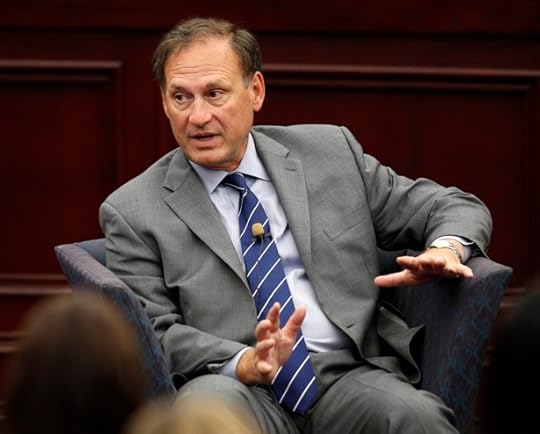
If the Supreme Court’s landmark decision on same-sex marriage is a slippery slope, where does it lead?
The most common—and often ridiculed—hypothetical that critics of the ruling cite is polygamy. If a marriage between two men or two women is suddenly a constitutional right, why can’t a group of people decide to wed? Yet to Justice Samuel Alito, the consequences of the high court decision go far beyond marriage. In a lengthy and revelatory interview with Bill Kristol of the Weekly Standard published Monday morning, Alito suggested that the concept of “liberty” envisioned in Justice Anthony Kennedy’s majority opinion could lead to a parade of potential horribles, and some of them might be just as concerning to progressives as they are to conservatives:
And there are many other conceptions. The Court’s conception, I said in this opinion and I believe to be true, is a very postmodern idea; it’s the freedom to define your understanding of the meaning of life. Your—it’s the right to self-expression. So if all of this is on the table now, where are the legal limits on it?
If a libertarian is appointed to the Supreme Court, is it then proper for the libertarian to say, “Well, I think that there is a right to work less than the minimum wage? I think there is a right to work as many hours as I want without being limited by the government. I think I have the right to build whatever I want on my property irrespective the zoning laws and so forth.”
If a socialist is appointed to the Supreme Court, can the socialist say, “I think that liberty and the 14th Amendment means that everyone should have a guaranteed annual income or that all education through college should be absolutely free,” or whatever. There’s no limit.
The entire interview runs more than an hour, but it’s worth watching for Alito’s extended commentary on the marriage case and the rare light it sheds on a justice who generates significantly less discussion than his conservative colleagues on the bench (particularly Chief Justice Roberts, Antonin Scalia, and Kennedy, the frequent swing vote). More predictable in his voting than Roberts or Kennedy, and less colorful than Scalia, Alito has sat on the Court for nearly a decade but is perhaps best known to the general public for shaking his head and mouthing “Not true” when President Obama criticized the Citizens United decision during his State of the Union address in 2010. (One noteworthy tidbit from the interview is that Alito remembers his father personally drawing up new legislative districts for New Jersey after a 1964 Supreme Court ruling created the standard of “one person, one vote”; the Court will consider that principle anew next term.)
Related Story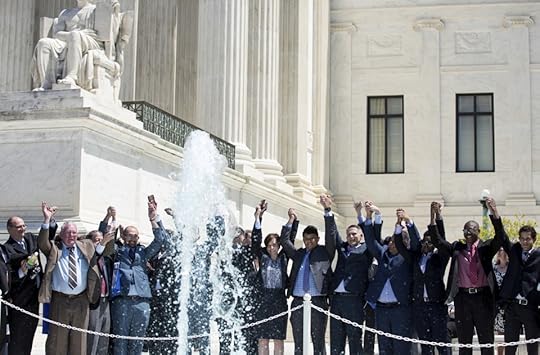
The Dangers of a Constitutional 'Right to Dignity'
Alito expands significantly on his dissent in the marriage case (one of four total), which touched on his slippery-slope concerns but focused more on the traditional definition of marriage and fears that the ruling would be used to “vilify” those who support it. If there’s a theme to Alito’s voting record on the court, it’s that he’s no libertarian. As he explained to Kristol, he was on the opposite side of the slippery-slope argument in a pair of earlier First Amendment cases, when he dissented from the high court’s expansive reading of the freedom of speech. In one case, Alito was the lone dissenter in a decision striking down a federal law banning the sale of so-called “crush” videos depicting animal cruelty. And he was again alone in opposing the Supreme Court’s 8-1 ruling in favor of Westboro Baptist Church, the anti-gay group that protests at military funerals. In the interview, Alito explained that those restrictions were “peripheral” to the core “political speech” principle of the First Amendment—unlike, say, the question in Citizens United of whether financial contributions constituted political speech, a decision that he emphatically defended.
The same-sex marriage case, Alito said, turned on the definition of the word “liberty” in the Fourteenth Amendment. Historically, the Court had limited liberty to rights “that were deeply rooted in the traditions of the country.” But Kennedy’s marriage ruling, he lamented, “threw that out.”
We are at sea, I think. I don’t know what the limits of substantive liberty protection under the Fourteenth Amendment are at this point.
Yet as Michael Dorf notes, Alito’s desire to rely on historical interpretation is no more than an ideological choice itself. “The conservatives’ use of history is highly selective,” said Dorf, a professor of constitutional law at Cornell University. He pointed out that it was Alito and his fellow conservatives on the Court who threw out the Court’s historical interpretation of the Second Amendment in finding an individual right to bear arms. They similarly had little use for history in their recent approach to affirmative action, he said. “Why do the conservatives, including Justice Alito, say nary a word about the historical understanding of race-conscious government programs when they strike down affirmative action programs?” Dorf asked. “Could it be because their own ideological preferences make what they would find there uncomfortable?”
In his interview with Kristol, Alito went on to suggest more worrisome implications for the Court's marriage ruling, predicting that the “hotly-debated issue” would linger. “It raises questions of legitimacy, it raises practical questions because the more the Court does this sort of thing, the more the process of nomination and confirmation will become like an election,” he said. “It will become like a political process.” As Alito well knows, it's hard to see how the Senate confirmation process could become any more politicized than it has been in the last decade. (On the other hand, imagine President Hillary Clinton trying to persuade a Republican Senate to confirm her nominee to replace, say, a retiring Antonin Scalia.)
The more interesting question that Alito raises is whether the Court has actually expanded the definition of liberty to the degree he suggests it has. It's similar to the one Jeffrey Rosen posed before the marriage decision in contemplating Kennedy’s “right to dignity.” He noted that in opposing Kennedy’s 2003 opinion in the Lawrence v. Texas case invalidating sodomy laws, Scalia said the ruling “decrees the end of all morals legislation.” Alito is going even further by suggesting that a ruling ostensibly limited to social policy could threaten economic regulations as well. It seems like quite a reach, but if he’s right, the Supreme Court’s ruling last month—already considered a landmark—would be far broader than almost anyone could imagine.









Sandra Bland and the Long History of Racism in Waller County, Texas

Waller County, Texas, has had a complicated racial history since the days when it was a part of Mexico. At one of its first settlements, Bernardo Plantation, about 100 slaves grew cotton on a large farm on the banks of the Brazos. Yet in the years before Texas fought Mexico for its independence, the area became a magnet for free blacks from elsewhere in the South who sought a welcoming home.
The messy, confusing double legacy of that history has persisted to the present, most recently embodied in the death of Sandra Bland in a Waller County jail cell. Bland, a 28-year-old from Chicago, was on a road trip to start a new job at her alma mater, historically black Prairie View A&M University, when she was pulled over by a state trooper for failing to signal a turn. Somehow, that apparently routine stop escalated and ended with Bland with an arm injury, under arrest for assaulting an officer. She was found dead in her cell three days later, on July 13, of what police say was suicide by asphyxiation. Her family disputes that account, saying she had no inclination to suicide and was upbeat about her new job.
We’ll need more information to understand what happened to Bland. As Radley Balko notes, jailhouse suicide is disturbingly common. Regardless of the circumstances of Bland’s death, however, a routine stop for failing to use a blinker should not end in several days of imprisonment and death. That has brought a natural focus on Waller County and the figures involved.
Related Story
A Year After Eric Garner's Death, Has Anything Changed?
After Walter Scott was shot and killed by a North Charleston, South Carolina, police officer, advocates noted that traffic stops are often a pretext for searching or questioning citizens of color. Scott, who was pulled over for having a taillight out, was wanted for failing to pay child support, and it’s speculated that led him to run away. He was shot in the back as he ran. In North Charleston, police made traffic stops involving African Americans far out of proportion to their percentage of the population. That isn’t the case in Waller County. Statewide, stops and citations for black people in Texas are actually lower than their share of the overall population, and the same holds true for stops by the Waller County sheriff and police in the towns of Hempstead and Prairie View.
But this might be one of the few areas where there isn’t evidence of racially disparate outcomes in Waller County, a place with a grim history of discrimination and tension—“racism from the cradle to the grave,” as DeWayne Charleston, a former county judge, put it to The Guardian.
The history is especially painful because Waller County was for a time a beacon of black progress. During Reconstruction, an office of the Freedmen’s Bureau opened in the county seat of Hempstead, and federal troops—including, for a time, some commanded by George Custer—occupied to keep the peace. Not coincidentally, the Ku Klux Klan also set up shop. Nonetheless, Hempstead became a locus of black political activity and hosted the Republican Party’s statewide convention in 1875. In 1876, the predecessor of Prairie View A&M was established, and in the 1880 Census, the county was majority black.
But the last two decades of the century saw an influx of white immigrants from Eastern Europe, and that dilution of the black vote, along with the end of Reconstruction, reduced blacks to a minority and slashed their political power. After a 1903 law established “white primaries,” African Americans were effectively shut out of politics—such that in a county with some 8,000 black voters, only 144 Republican votes were cast in 1912, according to The Handbook of Texas. Waller County, as Leah Binkovitz notes, had among the highest numbers of lynchings in the state between 1877 and 1950, according to a comprehensive report by the Equal Justice Initiative.
This may seem like distant history, but it set something of a pattern for the county’s race relations through to the present—and as the events of the last year have made clear, a place’s history is often an effective predictor of how it treats its black residents, from St. Louis County to Cuyahoga County. In fact, the disenfranchisement of black voters in Waller County has continued to be a source of contention.
In 2004, students at Prairie View A&M fought and won a battle over their right to vote in the country. District Attorney Oliver Kitzman claimed the students were ineligible to vote in Waller County and could only cast ballots in their home counties, despite clear Supreme Court precedent showing they were allowed to register. Kitzman threatened to prosecute any student who voted. It wasn’t his first clash with black residents, who accused the district attorney of deploying a range of intimidation tactics. Kitzman denied any racism, and told the Los Angeles Times that any racial issues in the county could be solved “if we took several of the players and sent them to Los Angeles.”
The students, with the support of conservative Republican state Attorney General Greg Abbott, triumphed in the battle. Kitzman resigned his post, a moment local black leaders compared to the Emancipation Proclamation. But four years later, PVAMU students again found themselves fighting for their fight to vote. A judge ruled against Waller County, and demanded that county officials justify every rejected voter registration to the U.S. Department of Justice for four years. The county has seen a variety of other accusations of voting irregularities in recent years.
The prosecutor said any racial issues could be solved “if we took several of the players and sent them to Los Angeles.”In the early 2000s, Hempstead was embroiled in a dispute over cemeteries in town, which had historically been divided between white and black. Black residents complained that the city had devoted much lesser resources to black burial grounds. In the midst of litigation, the white mayor of Hempstead offended the city’s African American residents by refusing to attend a parade to mark Juneteenth, the day of emancipation of slaves in Texas. The lawsuit was ultimately settled, with Hempstead agreeing to spend more on upkeep of the black cemeteries.
The interment question wasn’t entirely settled: In 2007, DeWayne Charleston, the judge, ordered a black funeral home to bury the body of an unknown white woman found dead in the county. (Charleston was later removed from the bench for accepting bribes.) Officials balked, as the Associated Press reported:
When activists started raising questions about the county's hesitation at burying the woman in a black cemetery, the commissioners asked a white-owned funeral home to handle arrangements—adhering to what community activists say is a long-standing tradition of cemetery segregation in the county .… Had the unidentified woman been buried in a black cemetery, she would have been the first known white person buried in a black cemetery in the county.
In 2007, the chief of police in Hempstead, Glenn Smith, was accused of racism and police brutality during an arrest. Council members opted to suspend Smith for two weeks, a sanction that disappointed civil-rights leaders in town. The following year, amid more allegations of police misconduct, Smith was fired. He promptly ran for county sheriff and won, and is now charged with investigating Bland’s death in the jail he oversees. At a news conference about Bland’s death, Smith vowed, “Black lives matter to Glenn Smith.”
It may not come as a surprise if Waller County’s African American residents don’t buy that. And they may not feel any better about the prosecutor who would handle any case. Elton Mathis, who holds Kitzman’s old job, has also been accused of pursuing racially disparate prosecutions. Last June, a black clergyman alleged that Mathis has threatened him over such accusations.
Almost as soon as Bland died, her family and many black Americans assumed the worst. They were skeptical of official explanations and pessimistic about the odds of a thorough and fair investigation. A popular hashtag, #IfIDieInCustody, became a forum to express that skepticism and the fear of being disappeared into a jail—or, like Freddie Gray, a police wagon—and emerging dead or near death, with no explanation and little evidence to explain what happened beyond the official account. To those Americans more accustomed to trusting the judicial system to deliver fair outcomes, this outpouring may come across as baffling at best—and as a hasty, unwise leap to conclusions at worst, short-circuiting the due process of the justice system. But the local history explains those deep wells of skepticism. Waller County has given African Americans more than a century’s worth of evidence that it is not in the habit of protecting their interests.









July 20, 2015
The 2016 U.S. Presidential Race: A Cheat Sheet

With John Kasich’s announcement Tuesday morning that he’s running for president, the Republican presidential field is now complete. Oh sure, there might be new candidates—former Virginia Governor Jim Gilmore seems likely to announce a campaign in August—but every candidate with even a small chance of making it to a debate stage in Cleveland (or past Super Tuesday, for that matter) has already leaped in.
In fact, Kasich might not make the stage, either—even though the first forum is being held in Ohio, the state where he’s governor. Despite a reputation for policy smarts, Kasich seems like a longshot, too moderate and technocratic for a Republican primary electorate, and possibly too peevish to handle voters and donors alike. But he’s a brainy candidate, his super PAC has raised a decent sum, and the fact that he hails from an important swing state will give him an outsize impact.
What is there to glean about the Republican field at this moment?
First, it’s enormous. There’s no modern precedent for a field this large, with 16 major candidates (plus scores of unknowns) officially in the hunt. It’s a headache for all involved: The candidates struggle to get attention; voters are swamped by a deluge of information; the media struggle to keep track of the candidates; pollsters grapple with the unwieldiness of their automated systems; the GOP scrambles to keep things in control; and TV networks puzzle over how to organize a debate.
Second, it looks almost nothing like what most analysts expected when I first began this guide back in January. At that point, there was no one in America who believed that Donald Trump was a serious candidate for president of the United States. Today, Trump has improbably filed to run, filed his required disclosures with the Federal Election Commission, and seems like a lock for a podium on stage in Cleveland on August 6. Let’s be clear: Trump will never be president, and much of his appeal may be media-driven. He can’t survive by taking potshots at the military service of John McCain. But a new Washington Post poll shows him well ahead, with almost double the support of his nearest rival, Governor Scott Walker of Wisconsin.
The rest of the field is nearly as surprising. Jeb Bush has proved himself a serious force in the race, quieting some doubters, but he has also been unable to position himself as a juggernaut and clear the field, despite a huge monetary advantage. Ted Cruz has looked more resilient than some analysts believed, while Rand Paul seems to have faded into the background recently. Carly Fiorina and Lindsey Graham have developed as fascinating forces in the campaign, even as neither has gained much popular support.
But the Democratic race is also a more interesting beast than it was in January. Hillary Clinton is still the odds-on favorite, but Bernie Sanders’s candidacy has drawn huge crowds, shifted the conversation, and forced Clinton to take liberal stands on a host of issues. Plus, he might be behind by several country miles kilometers—but who saw a Lincoln Chafee run coming?
With so many candidates in the mix—some announced, some soon to announce, and some still on the fence—it’s tough to keep track of it all. To help out with that, this cheat sheet on the state of the presidential field will be periodically updated throughout the campaign season. Here's how things look right now.
* * *
The Republicans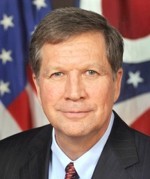 Wikimedia
Wikimedia John Kasich
Who is he? The current Ohio governor ran once before, in 2000, after a stint as Republican budget guru in the House. Between then and his election in 2010, he worked at Lehman Brothers. Molly Ball wrote the definitive profile in April.
Is he running? Yes: His announcement is July 21 at THE Ohio State University in Columbus.
Who wants him to run? Kasich’s pitch: He’s got better fiscal-conservative bona fides than any other candidate in the race, he’s proven he can win blue-collar voters, and he’s won twice in a crucial swing state. While his polling isn’t stellar, he still leads Graham, Fiorina, and Jindal.
Can he win the nomination? As Ball noted, Kasich seems in some ways perfectly suited to this race; in other ways, his insistent anti-charisma makes it very hard to imagine him winning, and his attitude is amusingly blasé: “If they like it, great. If they don’t like it, I’ll play more golf.” He could be hurt by his embrace of Medicaid expansion under Obamacare, a move he had to circumvent the Republican-led General Assembly to make.
When will he announce? July 21 at the Ohio State University.
What else do we know? He doesn’t own a smartphone, and seldom uses a computer. Maybe he can be friends with Lindsey Graham—the old way, via U.S. Mail.
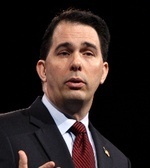 Gage Skidmore
Gage Skidmore Scott Walker
Who is he? Elected governor of Wisconsin in 2010, Walker earned conservative love and liberal hate for his anti-union policies. In 2013, he defeated a recall effort, and he won reelection the following year.
Is he running? Yes. He announced on July 13.
Who wants him to run? Walker's record as governor of Wisconsin excites many Republicans. He's got a solid résumé as a small-government conservative. His social-conservative credentials are also strong, but without the culture-warrior baggage that sometimes brings. And Walker has won three difficult elections in a blue-ish state. He’s said to be a favorite of the Koch brothers and their network.
Can he win the nomination? Very possibly. Despite his strengths, Walker has never run a national campaign and isn't exactly Mr. Personality. For now, he is solidly in the top tier of candidates.
Does his website have a good 404 page? Aye, matey.
What else do we know? Good news, bad news: Walker has a geographic advantage in his proximity to Iowa, but a potential biological disadvantage from his allergy to dogs.
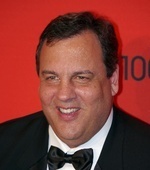 David Shankbone
David Shankbone Chris Christie
Who is he? What’s it to you, buddy? The combative New Jerseyan is in his second term as governor and previously served as a U.S. attorney.
Is he running? Christie kicked off his campaign June 30 at Livingston High School, his alma mater.
Who wants him to run? Moderate and establishment Republicans who don't like Bush or Romney; big businessmen, led by Home Depot founder Ken Langone.
Can he win the nomination? No. The tide of opinion had turned against Christie even before the "Bridgegate" indictments. Citing his horrific favorability numbers, FiveThirtyEight bluntly puns that “Christie's access lanes to the GOP nomination are closed.”
Does his website have a good 404 page? We would have gone with the GIF, but sure.
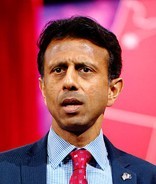 Gage Skidmore
Gage Skidmore Bobby Jindal
Who is he? A Rhodes Scholar, he’s the outgoing governor of Louisiana. He previously served in the U.S. House.
Is he running? Yes. He kicked off his campaign on June 24.
Who wants him to run? It’s hard to say. Jindal has assiduously courted conservative Christians, both with a powerful conversion story (he was raised Hindu but converted to Catholicism in high school) and policies (after other governors reversed course, he charged forward with a religious-freedom law). But he still trails other social conservatives like Ted Cruz and Mike Huckabee.
Can he win the nomination? Probably not. Jindal still lacks traction at the national level, he faces an overcrowded field of social conservatives, and his stewardship of the state of Louisiana has come in for harsh criticism even from staunch fiscal conservatives. It’s hard to see how he gains momentum from here.
What else do we know? In 1994, he wrote an article called “Physical Dimensions of Spiritual Warfare,” in which he described a friend’s apparent exorcism.
Does his website have a good 404 page? Meh. Good joke, but past its expiration date.
 Gage Skidmore
Gage Skidmore Donald Trump
Who is he? The real-estate developer and reality-TV star fired TV personality almost certainly isn’t worth as much as he wants you to think he is.
Is he running? Like, is he going to win the nomination? Of course not. But his wacky, offensive, ad-lib rise to the top of the Republican polls has been amazing.
Who wants him to run? Jon Stewart; Donald Trump. The rest of the Republican Party, however, seems horrified.
Can he win the nomination? When does this GIF stop seeming funny and accurate, and start seeming incorrect?

Not today! He’s still not gonna win.
What else do we know? He’s, like, a really smart person.
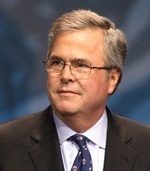 Gage Skidmore
Gage Skidmore Jeb Bush
Who is he? The brother and son of presidents, he served two terms as governor of Florida, from 1999 to 2007.
Is he running? Yes, as of June 15.
Who wants him to run? Establishment Republicans; George W. Bush; major Wall Street donors.
Can he win the nomination? Bush is a top-tier candidate, but just how strong he is remains unclear. Since jumping into the race, he has continued to poll well and raise lots of money. He seems like a lock to rack up all-important endorsements from top Republicans. But predictions that he would quickly come to dominate the field have not come to pass, and while many analysts predicted that his moderate record would cause trouble in Iowa and with grassroots activists, that problem seems to be deeper than expected. His poll numbers are probably helped by his name, which is a double-edged sword.
What else do we know? Since Bush's surprise announcement, he has tended to stay fairly quiet, delivering some big speeches and hitting fundraisers, but not making a great number of trips to Iowa or New Hampshire.
Does his website have a good 404 page? Yes—y en español también.
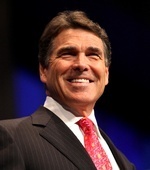 Gage Skidmore
Gage Skidmore Rick Perry
Who is he? George W. Bush’s successor as governor of Texas, he entered the 2012 race with high expectations, but sputtered out quickly. He left office in 2014 as the Lone Star State’s longest-serving governor.
Is he running? Yes. He announced on June 4.
Who wants him to run? Small-government conservatives; Texans; immigration hardliners; foreign-policy hawks. Noah Rothman makes a case here. (Perry's top backer four years ago, non-relative Bob Perry, died in 2013.)
Can he win the nomination? Perry and his backers insist 2016 Perry will be the straight shooter who oversaw the so-called Texas miracle, not the meandering, spacey Perry of 2012. We'll see. So far, his campaign has failed to catch on in polling, even as he wins acclaim as a drastically improved candidate.
Does his website have a good 404 page? That depends. Is this an “oops” joke? If so, yes.
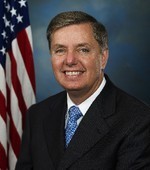 Wikimedia
Wikimedia Lindsey Graham
Who is he? A senator from South Carolina, he’s John McCain’s closest ally in the small caucus of Republicans who are moderate on many issues but very hawkish on foreign policy.
Is he running? He sure is. Graham kicked off the campaign June 1.
Who wants him to run? John McCain, naturally. Senator Kelly Ayotte, possibly. Joe Lieberman, maybe?
Can he win the nomination? Not really. The South Carolina senator seems to be running in large part to make sure there’s a credible, hawkish voice in the primary. It seems like Graham started his campaign almost as a lark but has started to enjoy the ride, plus he’s shown he’s a great performer on the stump. Molly Ball explores his chances at greater length here.
What else do we know? Graham promises to have a rotating first lady if he wins. We nominate Lana del Ray.
 Michael Vadon
Michael Vadon George Pataki
Who is he? Pataki ousted incumbent Mario Cuomo in 1994 and served three terms as governor of New York.
Is he running? Yes. He announced May 28.
Who wants him to run? It's not clear. Establishment Northeastern Republicans once held significant sway over the party, but those days have long since passed.
Can he win the nomination? No. As my colleague Russell Berman previously noted, Pataki is one of the longest of the long-shot GOP candidates. He has touted his leadership on 9/11, when he served as governor, but so did former New York City Mayor Rudy Giuliani. He was also a successful conservative governor in a deep-blue Northeastern state, but so was former Massachusetts Governor Mitt Romney. He seems to be socially liberal enough to alienate primary voters, but not enough to capture Democrats.
Does his website have a good 404 page? No.
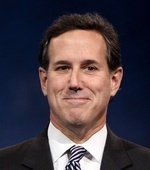 Gage Skidmore
Gage Skidmore Rick Santorum
Who is he? Santorum represented Pennsylvania in the Senate from 1995 until his defeat in 2006. He was the runner-up for the GOP nomination in 2012.
Is he running? Yes, with a formal announcement on May 27.
Who wants him to run? Social conservatives. The former Pennsylvania senator didn't have an obvious constituency in 2012, yet he still went a long way, and Foster Friess, who bankrolled much of Santorum's campaign then, is ready for another round.
Can he win the nomination? It's tough to imagine. Santorum himself said his chances would hinge on avoiding saying "crazy stuff that doesn't have anything to do with anything." For now, his poll numbers remain in the basement—but he surprised in 2012.
Does his website have a good 404 page? No.
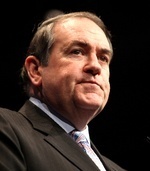 Gage Skidmore
Gage Skidmore Mike Huckabee
Who is he? An ordained preacher, former governor of Arkansas, and Fox News host, he ran a strong campaign in 2008, finishing third, but sat out 2012.
Is he running? Yes. He kicked off the campaign May 5.
Who wants him to run? Social conservatives; evangelical Christians.
Can he win the nomination? Huckabee's struggle will be to prove that he's still relevant. Since he last ran in 2008, a new breed of social conservatives has come in, and he'll have to compete with candidates like Ted Cruz. His brand of moral crusading feels a bit out of date in an era of widespread gay marriage—not least when he curiously chose to attack Beyoncé. (His statements in support of Josh Duggar have also earned him criticism and quizzical reaction.) He faces fire from strict anti-tax conservative groups for tax hikes while he was governor. And fundraising has always been his weak suit. But Huckabee's combination of affable demeanor and strong conservatism resonates with voters.
Does his website have a good 404 page? It’s pretty good.
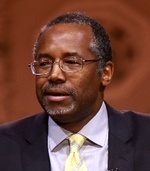 Gage Skidmore
Gage Skidmore Ben Carson
Who is he? A celebrated former head of pediatric neurosurgery at Johns Hopkins, Carson became a conservative folk hero after a broadside against Obamacare at the 2013 National Prayer Breakfast.
Is he running? Yes, after a May 4 announcement.
Who wants him to run? Grassroots conservatives, who have boosted him up near the top of polls, even as Republican insiders cringe. Carson has an incredibly appealing personal story—a voyage from poverty to pathbreaking neurosurgery—and none of the taint of politics.
Can he win the nomination? Almost certainly not. Carson's politics are conservative on some issues, but so eclectic as to be nearly incoherent overall. He's never run a political campaign, and has a tendency to do things like compare ISIS to the Founding Fathers. Despite initially building a formidable organization, he’s struggled to keep it together, with a rash of top staffers defecting.
Does his website have a good 404 page? No.
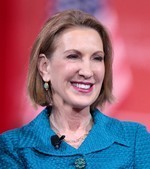 Gage Skidmore
Gage Skidmore Carly Fiorina
Who is she? Fiorina rose through the ranks to become CEO of Hewlett-Packard from 1999 to 2005, before being ousted in an acrimonious struggle. She advised John McCain’s 2008 presidential campaign and unsuccessfully challenged Senator Barbara Boxer of California in 2010.
Is she running? Yes, as of a May 4 announcement.
Who wants her to run? It isn’t clear what Fiorina’s constituency is. She’s a former CEO of Hewlett-Packard, but there are other business-friendly candidates in the race, all of whom have more electoral experience.
Can she win the nomination? Almost certainly not. Fiorina’s only previously political experience was a failed Senate campaign against Barbara Boxer in 2010. She has mostly been serving the role of harasser in the race so far, stirring up the news with slams on environmentalists for causing droughts (your guess is as good as mine), Obama for backing net neutrality, and Apple’s Tim Cook for speaking out on Indiana’s Religious Freedom Restoration Act. Mainly, though, she has strongly criticized Hillary Clinton, and some Republican strategists like the optics of having a woman to criticize Clinton so as to sidestep charges of sexism. Fiorina seems to be wowing voters in Iowa, but that hasn’t translated into national support—yet.
What else do we know? Fiorina's 2010 Senate race produced two of the most entertaining and wacky political ads ever, "Demon Sheep" and the nearly eight-minute epic commonly known as "The Boxer Blimp."
Does her website have a good 404 page? No.
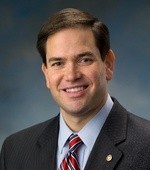 Wikimedia
Wikimedia Marco Rubio
Who is he? A second-generation Cuban-American and former speaker of the Florida House, Rubio was catapulted to national fame in the 2010 Senate election, after he unexpected upset Governor Charlie Crist to win the GOP nomination.
Is he running? Yes—he announced on April 13.
Who wants him to run? Rubio enjoys establishment support, and has sought to position himself as the candidate of an interventionist foreign policy.
Could he win the nomination? Charles Krauthammer pegs him as the Republican frontrunner. His best hope seems to be to emerge as a consensus candidate who can appeal to social conservatives and hawks, and he's even sounded some libertarian notes of late. He's well-liked by Republicans, and has surged forward since announcing, but he needs to move up from second choice to first choice for more of them. Rubio seems to scare Democrats more than any other candidate, too.
Does his website have a good 404 page? It’s decent.
 Wikimedia
Wikimedia Rand Paul
Who is he? An ophthalmologist and son of libertarian icon Ron Paul, he rode the 2010 Republican wave to the Senate, representing Kentucky.
Is he running? Yes, as of April 7.
Who wants him to run? Ron Paul fans; Tea Partiers; libertarians; civil libertarians; non-interventionist Republicans.
Can he win the nomination? At one time, Paul seemed like he might manage to break into the top tier despite being a radically unorthodox Republican. He's relatively permissive on drugs, passionate about civil liberties, and adamantly in favor of restraint on foreign policy. So far, however, his unusual candidacy isn’t taking off. Paul remains stuck in the rear-middle of the pack, he hasn’t picked up the big donors he hoped for, and his father’s backers remain wary of his overtures to the GOP establishment
What else do we know? One of Paul's greatest strengths is the base bequeathed to him by his father, three-time presidential candidate and former Representative Ron Paul. But as The Washington Post has reported, his father is also Senator Paul's biggest headache.
Does his website have a good 404 page? No.
 Wikimedia
Wikimedia Ted Cruz
Who is he? Cruz served as deputy assistant attorney general in the George W. Bush administration and was appointed Texas solicitor general in 2003. In 2012, he ran an insurgent campaign to beat a heavily favored establishment Republican for Senate.
Is he running? Yes. He launched his campaign March 23 at Liberty University in Virginia.
Who wants him to run? Hardcore conservatives; Tea Partiers who worry that Rand Paul is too dovish on foreign policy; social conservatives.
Can he win the nomination? Though his announcement gave Cruz both a monetary and visibility boost, he still carries serious weaknesses. Much of Cruz's appeal to his supporters—his outspoken stances and his willingness to thumb his nose at his own party—also imperil him in a primary or general election, and he's sometimes been is own worst enemy when it comes to strategy. But Cruz is familiar with running and winning as an underdog.
Does his website have a good 404 page? No.
 Gage Skidmore
Gage Skidmore Sarah Palin
Who is she? If you have to ask now, you must not have been around in 2008. That’s when John McCain selected the then-unknown Alaska governor as his running mate. After the ticket lost, she resigned her term early and became a television personality.
Is she running? A bizarre speech in January made a compelling case both ways.
Who wants her to run? Palin still has diehard grassroots fans, but there are fewer than ever.
Can she win the nomination? No.
When will she announce? It doesn't matter.
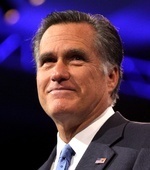 Gage Skidmore
Gage Skidmore Mitt Romney
Who is he? The Republican nominee in 2012 was also governor of Massachusetts and a successful businessman.
Is he running? Nah. He announced in late January that he would step aside.
Who wanted him to run? Former staffers; prominent Mormons; Hillary Clinton's team. Romney polled well, but it's hard to tell what his base would have been. Republican voters weren't exactly ecstatic about him in 2012, and that was before he ran a listless, unsuccessful campaign. Party leaders and past donors were skeptical at best of a third try.
Could he have won the nomination? He proved the answer was yes, but it didn't seem likely to happen again.
 Gage Skidmore John Bolton
Gage Skidmore John Bolton Who is he? A strident critic of the UN and leading hawk, he was George W. Bush’s ambassador to the UN for 17 months.
Is he running? Nope. After announcing his announcement, in the style of the big-time candidates, he posted on Facebook that he wasn’t running.
Who wanted him to run? Even among super-hawks, he didn’t seem to be a popular pick, likely because he had no political experience.
Could he have won the nomination? They say anything is possible in politics, but this would test the rule. A likelier outcome could be a plum foreign-policy role in a hawkish GOP presidency.
Others Still in the Mix:
Bob Ehrlich, Peter King, Harold Stassen, Jim Gilmore
* * *
The Democrats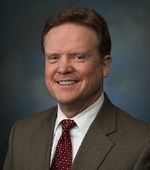 Wikimedia
Wikimedia Jim Webb
Who is he? Webb is a Vietnam War hero and secretary of the Navy. The author of several books, he served as a senator from Virginia from 2007 to 2013.
Is he running? Yes, as of July 2.
Who wants him to run? Dovish Democrats; socially conservative, economically populist Democrats; the Anybody-But-Hillary camp.
Can he win the nomination? Very doubtful. While Webb was the perfect candidate for Senate from Virginia in 2006, his statement in support of the Confederate flag shows why he probably has little hope in the national Democratic Party.
What else do we know? Read Webb’s longtime friend James Fallows on why he wants Webb in the race.
Does his website have a good 404 page? No.
 Wikimedia
Wikimedia Hillary Clinton
Who is she? As if we have to tell you, but: She’s a trained attorney; former secretary of State in the Obama administration; former senator from New York; and former first lady.
Is she running? Yes.
Who wants her to run? Most of the Democratic Party.
Can she win the nomination? A better question is whether she can lose it. Not yet!
What else do we know? The real puzzler, after so many years with Clinton on the national scene, is what we don't know. Here are 10 central questions to ask about the Hillary Clinton campaign.
Does her website have a good 404 page? If you’re tolerant of bad puns and ’90s ’80s outfits, the answer is yes.
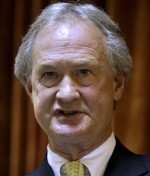 Steven Senne / AP
Steven Senne / AP Lincoln Chafee
Who is he? The son of beloved Rhode Island politician John Chafee, Linc took his late father’s seat in the U.S. Senate, serving as a Republican. He was governor, first as an independent and then as a Democrat.
Is he running? Yes—he announced his run at George Mason University on June 3.
Who wants him to run? Beyond metric-system boosters? No one knows! Even in Rhode Island, Chafee doesn’t have much support—he opted not to seek reelection as governor in 2014, in part because his approval rating had reached a dismal 26 percent.
Can he win the nomination? No. Chafee seems to be positioning himself as an economic populist and says Clinton's 2002 vote for the Iraq war should disqualify her (he was the only Republican senator to vote against it). In other words: He's Jim Webb with a less impressive resume, a less compelling bio (he's the son of longtime Senator John Chafee), and less of a political base. He gives himself even odds, though.
Does his website have a good 404 page? No.
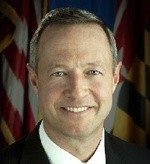 Wikimedia
Wikimedia Martin O'Malley
Who is he? He’s a former governor of Maryland and mayor of Baltimore.
Is he running? Yes. He announced his campaign on May 30.
Who wants him to run? Not clear. He has some of the leftism of Bernie Sanders or Elizabeth Warren, but without the same grassroots excitement.
Can he win the nomination? Probably not. At the moment, O’Malley seems caught between Sanders, who has grasped the progressive mantle, and Clinton, who dominates the Democratic race overall. As with Sanders, though, it’s hard to see where O'Malley would get an opening unless Clinton’s campaign fell apart. The conventional wisdom since protests over the death of Freddie Gray is that protests in Baltimore undermine the case for his candidacy and make it harder for him to run, but he’s embraced the protests as a motivation for his run.
What else do we know? Have you heard that he plays in a Celtic rock band? You have? Oh.
Does his website have a good 404 page? No.
 Wikimedia
Wikimedia Bernie Sanders
Who is he? A self-professed socialist, Sanders represented Vermont in the U.S. House from 1991 to 2007, when he won a seat in the Senate.
Is he running? Yes. He announced April 30.
Who wants him to run? Far-left Democrats; socialists; Brooklyn-accent aficionados.
Can he win the nomination? It remains extremely difficult to see him winning the nomination, on the basis that primary voters tend to gravitate to “electable” general-election candidates alone. But Sanders has improbably become a huge force in the Democratic Party, making questions about inequality and economics central to the campaign and tugging Hillary Clinton to the left.
Does his website have a good 404 page? Yes, and it is quintessentially Sanders.
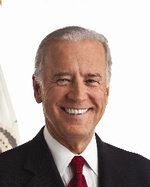 Wikimedia
Wikimedia Joe Biden
Who is he? Biden, a longtime Delaware senator, is vice president and the foremost American advocate for aviator sunglasses and passenger rail.
Is he running? He's made no serious steps toward a run, but whispers have grown since the death of his son Beau Biden in May. The Biden family hadn’t publicly noted that Beau Biden was ill, but his father’s time seems to have been absorbed with caring for him.
Who wants him to run? The Wall Street Journal reports that both Beau Biden and his brother Hunter encouraged their father to run. The group Draft Biden (slogan: “I’m Ridin’ With Biden”) continues to do its best. But so far, the vice president has made few steps that would suggest a real campaign.
Can he win the nomination? If Clinton didn't run, it would throw the Democratic field into disarray. But probably not. At 72, Biden would also be an unusually elderly candidate.
When will he announce? It seems likely that he won't.
 Wikimedia
Wikimedia Elizabeth Warren
Who is she? Warren has taken an improbable path from Oklahoma, to Harvard Law School, to progressive heartthrob, to Massachusetts senator.
Is she running? No. Seriously, no.
Who wants her to run? Progressive Democrats; economic populists, disaffected Obamans, disaffected Bushites.
Can she win the nomination? No, because she's not running.









Al Gore Dreamed Up a Satellite—and It Just Took Its First Picture of Earth

One night in February 1998, Vice President Al Gore awoke with a start.
He had dreamed of a satellite. It would sit far out in space, beyond the reach of more conventional orbiters, so distant it could capture all of planet Earth in one camera lens. It would then beam this view—the whole planetary disk, a la The Blue Marble—down to the planet below. The video would be live streamed on the Internet.
He couldn’t shake the idea. It had as much to do with sharing that vantage point—Earth as a single planet, home to all of the life we know in the universe—as it did with the technology required to make it happen.
“We all live on the same planet,” Gore told me in an interview on Monday. “We all face the same dangers and opportunities, we share the same responsibility for charting our course into the future.”
Soon after his dream, the vice president met with the director of NASA, who said that the agency could pull it off for less than $100 million. The project went forward. It was nicknamed “Goresat.”
Then 15 years of politics happened. Funding for the project came through, and the satellite (now called Triana) was built. But Republicans were never fond of the project—having, as it did, Clintonian connotations—and the incoming Bush administration postponed the spacecraft’s launch. So it sat in a closet for seven years.
That’s when NOAA and the U.S. Air Force began to take interest in it. “Goresat” was designed to sit at the first Lagrangian point, a calm spot between the gravitational eddies of the Earth and the sun. That’s also where solar weather observatories sit—and the two agencies needed a new sun-monitoring satellite, as their old one was getting on in years. NOAA and the Air Force provided funding to retrofit, launch, and maintain the satellite, which was newly dubbed the Deep Space Climate Observatory, or DSCOVR.
That’s how a satellite conceived in a vice president’s 1990s dreams finally launched in February of this year. And though it’s been adjusted to principally monitor solar wind, DSCOVR still has one eye turned back to Earth. Its Earth Polychromatic Imaging Camera—or, ahem, EPIC—will still capture an image of the whole planet many times a day. This camera will monitor specific wavelengths that alert scientists to the presence of certain materials like ozone, aerosols, and volcanic ash; but it will also generate a full disk photo 11 times a day.
In fact, it just did. On July 6, 2015, DSCOVR captured its first image of planet Earth—a view of North and Central America taken at solar noon. NASA and NOAA released the photo on Monday. The two agencies say they’re still working out some final kinks (the image has a bluish tint common to uncalibrated space pictures), but that, in September, pictures should start flowing 12 to 36 hours after they’re taken.
 DSCOVR’s first full-disk image of Earth (NASA / NOAA)
DSCOVR’s first full-disk image of Earth (NASA / NOAA) And that’s a big deal. Captured by Apollo astronauts coming back from the moon in December 1972, The Blue Marble is the first photo to show the entire globe in one frame. It has since been hailed as one of most important—and most reproduced—photos ever taken, an icon of globalism, humanitarianism, and the modern environmental movement.
“When I moved into my office in the West Wing of the White House in January of 1993, I asked NASA for a very large version of that picture to put on my wall,” Gore told me Monday. “It stayed there for eight years.”
“After the first six of those eight years, I asked NASA if they had another one—and I was surprised, just because I didn’t know the full story at that point, when they told me ‘no, that’s the only one, there’s not another one,’” he said.
Astronauts don’t go to the moon anymore, so we have relatively few new images of the entire Earth, captured all at once. Sure, we have lots and lots of images of parts of Earth, taken many times a day, which can be stitched together to give a complete picture of the globe, but there’s something about that whole-planet view: a sense of completeness, of closedness. It also has real scientific uses: A picture of the whole Earth measures the planet’s changing albedo in a way that composites don’t.
Gore said that, seeing the first picture on Monday, he felt gratitude to everyone who worked to put the craft into orbit. Be he also “felt something of the same emotion that I felt when I saw the first Blue Marble photo 42 and a half years ago, when I saw the first Earthrise image just four years prior to that.”
“It’s not an accident that that first image, called Earthrise, led to the passage of major environmental laws in the United States during the presidency of Richard Nixon, nor is it a coincidence that the first Earth Day was organized less than a year and a half after that first picture was seen. It changed, that picture changed, the way we thought about ourselves and our relationship to the Earth,” said Gore.
That orb is all we have to work with, and its picture is an image of our edges. DSCOVR will give us that view many times a day—and do it pretty inexpensively, too. Countless data sets and records depict some aspect of Earth and humanity at this point in our history: measures of GDP, of temperature, of births and deaths. To all those, we’re now adding this simple, important one.









The Chain Reaction That Doomed SpaceX's Rocket

A steel strut holding a helium bottle inside a SpaceX Falcon 9 rocket snapped during flight, setting off a chain reaction that destroyed the rocket during a June launch, the company’s CEO and chief rocket-designer Elon Musk said.
“One of those struts failed and was unable to hold the helium bottle down, and the helium bottle would have shot to the top of the tank at high speed,” Musk said in a call with reporters today, characterizing his analysis as an “initial assessment” that is highly probable but not definitive.
Fixing the problem will delay the SpaceX’s launch schedule by at least a month, with no new flights until at least September. The company had previously scheduled its next flight in early August. Musk says the delays will mean hundreds of millions of dollars in lost revenue.
The helium bottles are stored within the liquid-oxygen fuel tank to sustain pressure as the fuel is consumed during flight. Pre-flight tests apparently missed the flaw in the strut because the stress increases at higher g-force pressure. Musk said that after the crash, SpaceX tested thousands of struts from the supplier that made them, and discovered several that failed below their rated tolerances.
Figuring out what went wrong is a make or break task for SpaceX.“Obviously, what we’re going to do in the future is not use these particular struts, and we’re going to move to individually testing each strut independent of any material certifications,” Musk said. “There will be some cost increase to the rocket, and not we believe to a significant amount.”
The June 28 launch at Cape Canaveral—the 18th in what was then an uninterrupted series of successful flights by the Falcon 9 rocket—was supposed to bring supplies and research materials to the International Space Station, but ended in an explosive deconstruction after two minutes of flight.
On July 5, Musk announced that he would have answers within the week, but no announcement was forthcoming until the company invited reporters to today’s press conference.
Figuring out what went wrong is a make or break task for SpaceX. Beyond the cost of the $60 million rocket and four tons of supplies, the Falcon 9 is the company’s work-horse product. Some $7 billion in revenue is at stake from 50 scheduled missions set to use the rocket.
More From Quartz The First Successful Drone Delivery in the US Has Taken Place PayPal Once Worried No One Would Buy Stuff Online Facebook is Now Bigger Than General ElectricSpaceX has a contract to lift an ocean-studying satellite on behalf of a joint EU-U.S. mission in August; neither the company nor the partners has commented on whether the mission will go forward as planned. Nearly every major satellite company is counting on SpaceX to put satellites into space within the next year, including Iridium, SES, Eutelsat, and Orbcomm.
SpaceX’s low cost and high speed attracted these clients, but if it cannot quickly repair the fault, the company may be in trouble, although alternative options for its clients are limited: The latest generation of Russian rockets has proven unreliable, and flight schedules are packed at major launch companies like like Arianespace and United Launch Alliance, a joint venture of Lockheed Martin and Boeing.
NASA, which hired SpaceX to bring supplies to ISS, is also facing a conundrum. Its two commercial partners, SpaceX and Orbital ATK, have both experienced mission failures in the last year, even as one Russian mission went wrong in the spring, putting ISS within a month of tapping its food reserves. A different Russian mission successfully re-supplied the station earlier in July.
“This is the first time we’ve had a failure in seven years,” Musk said. “I think to some degree, the company as a whole became maybe a little bit complacent after 20 successes in a row.”









Atlantic Monthly Contributors's Blog
- Atlantic Monthly Contributors's profile
- 1 follower



